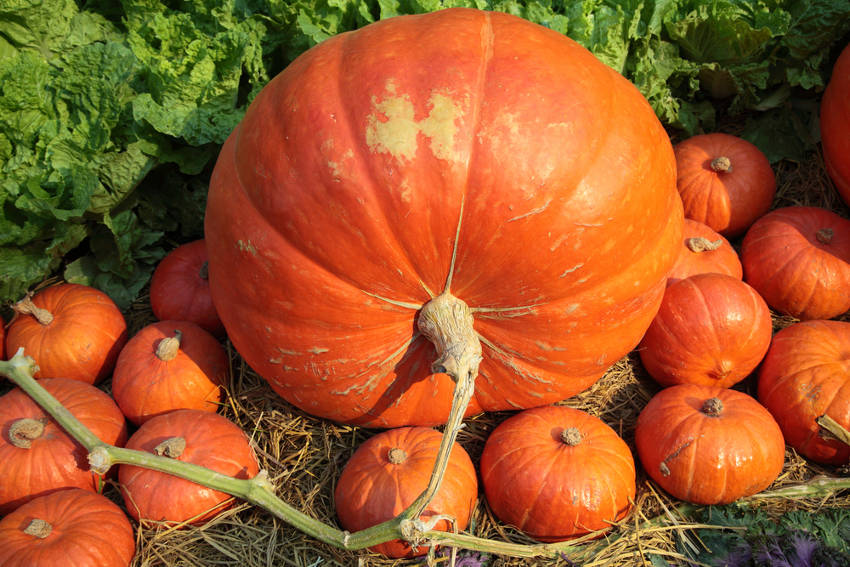People grow their own food for many reasons. Taste, sustainability, and simple enjoyment are all excellent reasons for getting your hands dirty in the vegetable bed. However, for some growers, size really matters and the race is on to grow the largest possible example of their favourite variety.
In the esoteric world of competitive growing, pumpkins are one of the most popular and spectacular crops. Generations of knowledge, lore, and superstition go into growing the true giants among gourds, and while you might not aim to compete at quite this level, you can certainly take the lessons learned and use them to grow some impressively large specimens of your own.
Choosing Your Seeds
There are hundreds of types of pumpkin, squash, and gourd seeds, and the botanical boundaries between the different varieties aren't always clear. Some are bred for tasty sweetness, some for resilience to pests and disease, and others for decorative looks.
But of course, if you're looking for size, it's essential to choose a variety that has the potential for greatness. One of the most common varieties among competitive growers is Atlantic Giant, which reached a then world record weight of 782kg in 2009. Today's even larger behemoths are usually descended from this groundbreaker.
But for more casual gourd gardeners, the Big Max variety makes an excellent alternative. In ideal conditions, it can provide fruits of up to 220kg, but its produce is more commonly in the still-impressive 10kg to 50kg range. This particular variety has the added advantage of tastier, sweeter flesh than the outright size fiends, making it a useful crop in the kitchen as well as an impressive one in the garden.
Planting Your Pumpkins
Pumpkins should be sown in late spring when all chances of frost have passed. They generally take around 120 days from sowing to bearing ripe fruit. However, if your priority is size, then every extra day's growing counts. Sowing indoors can give you a couple of weeks extra if your season is short.
Whether you're starting your pumpkins indoors or sowing them directly, their final growing location should provide full sun and some protection from wind. The soil should be slightly acidic for ideal results, but this isn't a huge factor in your potential success.
What really matters is that your pumpkin vines should have easy access to plenty of nutrition and water to funnel into their fruits. However, they also require good drainage. To provide these conditions, plant each vine in a mound of soil about a metre in diameter and 30cm high, enriched with plenty of well-rotted manure or garden compost.
Spacing Considerations
Spacing is an issue for pumpkins, and it's even more important if you're aiming for outsize fruits. The vines will sprawl and ramble across your bed with enthusiasm, and larger varieties can produce trailers reaching five meters or more in length.
Conventional growing usually sees individual plants spaced between one and two metres apart, with the vines kept under control by pruning or being pegged into a neat circle.
However, for larger fruits, you should allow the vines free rein and plant them even further apart. The more leaves each plant produces, the more nourishment the pumpkins will receive, and so allow plenty of room for them to flourish.
Setting and Choosing Fruit
Once established, the pumpkin plants will produce the first set of male flowers, recognisable by their long stems. For now, you can ignore these.
What you're really looking for is the female flowers, which feature a tiny pumpkin at their base. If these flowers first appear on weak and underdeveloped vines, remove them quickly before they can set fruit.
But if your plants are sturdy and vigorous, for each one choose two or three of the healthiest-looking flowers on the thickest stems, and remove the rest. To get a head start, pollinate the remainders using pollen from the male flowers, or you can wait and allow the local bee population to help out with this task.
Once the resulting fruit has grown to roughly the size of a tennis ball, remove all but the largest. This survivor is now the focus of all the growing efforts for that one vine.
Ongoing Care
Pumpkins are eager growers and require little delicate care. They can be vulnerable to slugs and snails in the early weeks, but once established require only plenty of water and regular feeding.
Use a nitrogen-rich fertiliser before flowering, a phosphorous-rich formula when flowers appear, and a potassium-rich one once the fruits have started to develop.
The only major risk to health is from mould and rot. Always water at the base of the plant rather than over the leaves, and once the fruits have become heavy enough to touch the ground, lay them on a flat stone or tile to keep them away from damp soil.
Harvesting
Since you're aiming for size, leave your pumpkins as long as possible before harvesting. However, it's essential to cut them before the first frost which will kill the plants surprisingly quickly. When harvesting, leave a few centimetres of stem attached to the pumpkin to prevent any fungus or infection entering the fruit itself. Harvested like this, they will keep for months in cool, dark conditions.
If this is your first time growing pumpkins, it's very unlikely you'll scale the heights of the competitively grown gourds. However, with a little care and attention, you can easily produce impressive fruits that will look amazing in your garden and provide plenty of fun along the way.






